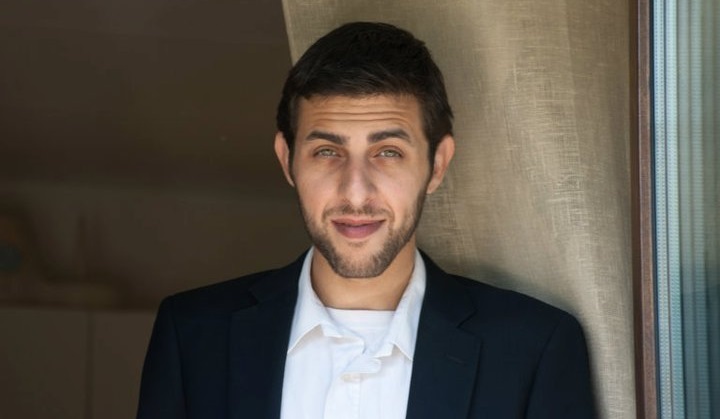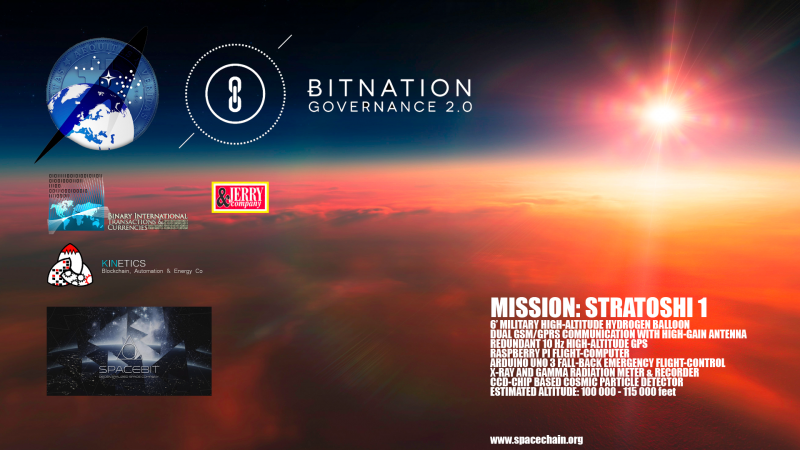A new decentralized space venture has recently begun, formed by a recent partnership with BitNation and Spacechain. R.O.S.S. (Race to Open Source Space) is a small rocket being prepared by the two teams. The mission of the program is to compete directly with space operations owned and operated by the nation states and private businesses. CEO BitNation, Susanne Tarkowski Tempelhof explains:
“Space exploration is something that nation state governments traditionally been providing, mainly because it required a significant amount of money. However, it has started to move to the private sector lately, with companies like SpaceX and Tesla, which were just the beginning of democratizing the technology, making it mainstream accessible. We aim to take it further, not just make it accessible to people outside of the government, but also make it open source, and DIY friendly.”
One of the steps in the organization's roadmap is the June 26 launch of Stratoshi – pending favorable weather conditions - which will be one of many high altitude balloon experiments to test the technology. The long term goal of this new space program is to create a peer-to-peer research service to study the cosmos. The rocket will host an FM transmitter to produce an idea called participatory proof-of-concept.
These efforts will be headed by Iman Mirbioki of Spacechain. He says “The very special essence of this idea is open source and decentralize space-travel; a space agency that is not bound to any nation or state.” Echoing BitNation’s mission statement, Susanne Tarkowski Tempelhof felt joining forces with Mirbioki was a "natural fit" and says “many new ideas have formed from the collaboration".
One such idea is the implementation of a new eco-friendly fuel. R.O.S.S. will use the new fuel in its thrusters for separation of the payload from the second stage. (R.O.S.S. is a two-stage rocket)
Cointelegraph spoke with Susanne Tarkowski Tempelhof and rocket builder Iman Mirbioki in the run-up to this week’s test launch.

Cointelegraph: Can you tell us the logic behind a BitNation Space Agency?
Susanne Tarkowski Tempelhof: One of Bitnation’s service offering is service aggregation. Even if many can conceptually understand that free market organizations can offer the same services as nation state governments, people tend to be scared by imagining a world where everyone have to do so many choices about individual service provider for every single service the government currently provides. It feels insecure, and messy. Therefore, combining everything under one banner is a part of Bitnation’s mission to illustrate not only how a decentralized governance world is achievable, but also more practical and comfortable.
Space exploration is something that nation state governments traditionally been providing, mainly because it required a significant amount of money. However, it has started to move to the private sector lately, with companies like SpaceX and Tesla, which were just the beginning of democratizing the technology, making it mainstream accessible. We aim to take it further, not just make it accessible to people outside of the government, but also make it open source, and DIY friendly.
To crowdfund collectivist efforts, whether it’s building roads, or space missions, or finding the cure for cancer is the natural next step in terms of building a voluntary society.
CT: Can you talk about the unique fuel that will be used in R.O.S.S.?
Iman Mirbioki: There is still a lot of testing to do before we can produce a stable fuel ready for use. The small amounts that will be used in orbit for a coming mission and in ROSS are produced and mixed by hand. We still don’t have the technology to produce it on industrial scale as the current synthesis process requires more resources and energy than ordinary “rocket fuel”. It’s one of obstacles we’re trying to tackle right now.
The objective of using the new fuel (we don’t have an official name for it) is also testing it in harsh environment. You see, it’s really pretty harsh up there; it’s ~400 degrees Celsius in temperature differences in light vs. shadow. There’s no gravity. Everything is bombarded all the time by all kind of radiation in all possible frequencies of the electromagnetic spectrum, not talking about the particle radiation that burns the computer-chips and fries the electronics.
The new fuel must be reliable under those conditions, to name a few - after all, fuel is the mission-critical “component” number one of all things. No fuel, no nothing.

CT: What's the goal behind the FM transmitter effort?
STT: The goal with the FM transmitter is to have a participatory proof-of-concept, so that everyone who’s interested in taking part of the mission can tune in, and listen to it when it’s in space.
We’ll broadcast Bitnation’s Declaration of Independence along with David Bowie’s “Space Oddity.” Considering that Bitnation, as opposed to other governance service providers, operates from cyberspace to a global, borderless world, it makes perfect sense to broadcast our declaration of independence from Space.
“Bitnation’s mission to illustrate not only how a decentralized governance world is achievable, but also more practical and comfortable. We'll integrate it into the Bitnation Pangea platform, so the community can review projects, contribute with input, and help fund it."
— Susanne Tarkowski Tempelhof
CT: Do you expect to launch on schedule?
IM: A lot depends on the outcome of the Stratoshi 1 mission that is headed for the stratosphere in a few weeks. The objective of the mission is to send up electronics and equipment to be stress-tested in near-space conditions, using a high-altitude balloon. The second objective of the Stratoshi 1 mission will be to remotely pilot a 1/12-size model of our experimental Phaeton spacecraft from freefall to safe landing in Stockholm.
The model is a V-shaped “wing”, with a wingspan of 1800 mm, weighing only 1600 grams despite the size and all the electronics. It will be dropped from 30-35 km altitude (100-115,000 ft) and we’ll do a miniature reentry simulation while we’re up there anyways. ROSS is also the (a smaller) kind of boosters the Phaeton spacecrafts will use in the future.

CT: How do you feel about the current Nation States space programs?
STT: Current nation state governments are still leading the way when it comes to space exploration — and some programs are indeed very interesting, like the NASA Mars exploration program, for instance. However, it’s like everything the government is doing: closed-sourced and elitist, which is the very opposite of what we’re trying to do at Bitnation.
CT: What can you tell Cointelegraph about the project's next step after reaching orbit?
IM: There are tons of opportunities. For example, mining titanium, an expensive metal which when shipped back from the Moon with current technology is still cheaper than mining it on Earth. The best ores on Earth contain ~3% or (often) less titanium vs. ~14% on the Moon, but also the absence of an atmosphere and liquid water have kept the minerals close to the lunar surface. That means, you don’t have to dig too much either.
The mining industry is also a heavy polluter on Earth. It’s a win-win situation for everyone. To get there, a fuel depot network in orbit must be deployed and that’s where the next steps go.
"I finally realized that traveling to space is not that hard as it seemed. I had dreamed of becoming an astronaut my whole entire life without even thinking of the very idea that one don’t need a government-run organization and billions of dollars to build a space vessel. After all, ‘space’ is only merely 100 km above us, with all its wonders, dangers, possibilities and adventures. The key is not a new fuel, better engines or sharper technology. We’ve been looking at it the wrong way all the time. When you change your perspective, suddenly you realize that you were wrong and that there are other ways."
— Iman Mirbioki, Spacechain Lead Developer
CT: What's the overall goal of this Space Mission for your team?
IM: There will be several missions going on at the same time at BSA. Different teams works with different tasks, like one that is working with drones flying in swarms. It doesn’t look like space science, but it’s exactly what it is. The same navigational software will be used for multi-satellites in orbit.
Putting something in orbit is one thing. It’s no longer “rocket science,” even if it’s rocket science. It’s in the reach of most common people if they really try it hard. Now, keeping something, or worse, somebody alive in orbit and bringing this poor being safely back to Earth (in one shape and not roasted) is another story.
There will be many successful launches, many discoveries, many milestones and tons of knowledge and data, but there will also be catastrophes and worse, it may even cost the lives of those who seek further in what is possible, before we get there - but we will get there no matter what.
The goal is very simple. We can’t live in the cradle forever. It’s essential for the survival of our species that we evolve further in space travel before we run out of resources, which is not so far away. It’s a matter of survival.

